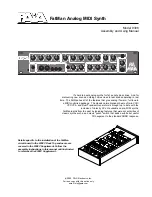
23
Trigon-6 User’s Guide
Filter Envelope
attack
decay
sustain
release
amplitude
time
note off
note on
A typical 4-stage envelope
Attack:
Sets the attack time of the envelope. The higher the setting, the
slower the attack time and the the longer it takes for the filter to open
from the level set with the filter
cutoff
knob to the level set by the filter
envelope amount. Percussive sounds typically have sharp (short) attacks.
Decay:
Sets the decay time of the envelope. After a sound reaches the
filter frequency set at its attack stage,
decay
controls how quickly the
filter then transitions to the cutoff frequency set with the
sustain
knob.
The higher the setting, the longer the decay. Percussive sounds, such as
synth bass, typically have shorter decays (and a generous amount of low-
pass filter resonance).
Sustain:
Sets the filter cutoff frequency for the sustained portion of the
sound. The sound will stay at this filter frequency for as long as a note is
held on the keyboard.
Release:
Sets the release time of the envelope. This controls how
quickly the filter closes after a note is released.
The description of envelope behavior above is true when the
envelope
amount
parameter is set to a positive value. But since this control is actually bi-polar, it is
possible to set a negative amount of modulation. In this case, the envelopes are
inverted and their behavior changes. The best way to get a feel for the difference is to
experiment with both positive and negative settings of the
envelope
amount
parameter.
The cutoff frequency setting may limit the effect of the envelope on the filter.
For example, if
cutoff
is at its highest setting, a positive envelope amount will have no
effect on the filter since the filter is already completely open.













































